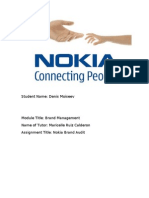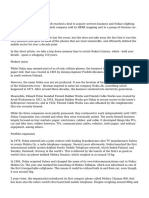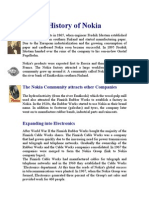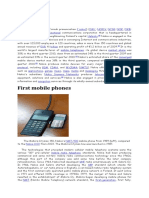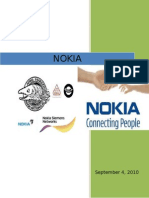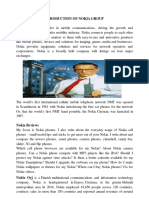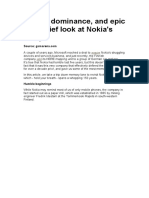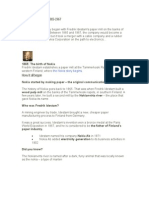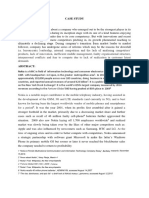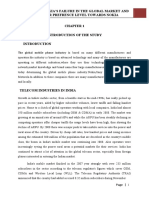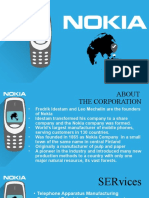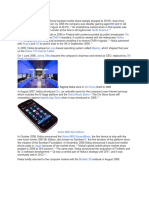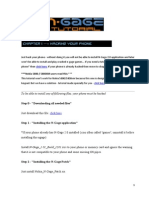1990–2010[edit]
Jorma Ollila, who oversaw the rise of Nokia in the mobile phone market as
CEO from 1992 to 2006
Following Simo Vuorilehto's appointment as CEO, a major restructuring was planned. With 11
groups within the company, Vuorilehto divested industrial units he deemed as un-strategic. Nokian
Tyres (Nokian Renkaat), a tyre producer originally formed as a division of Finnish Rubber Works in
1932, split away from Nokia Corporation in 1988. Two years later, in 1990, Finnish Rubber Works
followed suit. In 1991, Nokia sold its computer division, Nokia Data, to UK-based International
Computers Limited (ICL), the precursor of Fujitsu Siemens. Investors thought of this as financial
trouble and Nokia's stock price sank as a result. Finland was now also experiencing its worst
recession in living memory, and the collapse of the Soviet Union, a major customer, made matters
worse.
Vuorilehto quit in January 1992 and was replaced by Jorma Ollila, who had been the head of the
mobile phone business from 1990 and advised against selling that division. Ollila decided to turn
Nokia into a 'telecom-oriented' company, and he eventually got rid of divisions like the power
business. This strategy proved to be very successful and the company grew rapidly in the following
years. Nokia's operating profit went from negative in 1991 to $1 billion in 1995 and almost $4 billion
by 1999.[33]
Nokia's first fully portable mobile phone after the Mobira Senator was the Mobira Cityman 900 in
1987. Nokia assisted in the development of the GSM mobile standard in the 1980s, and developed
the first GSM network with Siemens, the predecessor to Nokia Siemens Network. The world's first
GSM call was made by Finnish prime minister Harri Holkeri on 1 July 1991, using Nokia equipment
on the 900 MHz band network built by Nokia and operated by Radiolinja. In November 1992,
the Nokia 1011 launched, making it the first commercially available GSM mobile phone.[34]
Salora Oy as a Nokia subsidiary ended in 1989 when the division was merged into Nokia-Mobira Oy.
The brand continued to be used for televisions until 1995.
On 12 June 1996, Nokia announced the sale of its television business to Canada/Hong Kong-
based Semi-Tech Corporation.[35] The television manufacturing plant in Germany closed down in
September 1996. The sale included a factory in Turku, and the rights to use the
Nokia, Finlux, Luxor, Salora, Schaub-Lorenz and Oceanic brands until the end of 1999.[36] Some of
these brands were later sold to other companies.
Nokia was the first to launch digital satellite receivers in the UK, announced in March 1997.[37] In
August 1997 Nokia introduced the first digital satellite receiver with Common Interface (CI) support.
[38]
In 1998 Nokia became the chosen supplier to produce the world's first digital terrestrial
television set-top boxes by British Digital Broadcasting (BDB), which was eventually launched
as ONdigital.[39]
� A Nokia Mediamaster set-top box
In October 1998, Nokia overtook Motorola to become the best-selling mobile phone brand,[40] and in
December manufactured its 100 millionth mobile phone.[41] A major reason why Nokia grew against
its main competitors Motorola and Ericsson was that it managed to cater to the consumer youth
market and fashion-oriented consumers, most significantly with the Nokia 5110 and 3210 handsets
which featured a large range of colourful and replaceable back-covers called Xpress-on.[42][43] One of
the earliest fashion phones in 1992, from Swiss watchmaker Swatch, was based on
Nokia's 101 handset.[44] The company would also form the Vertu division, creating luxury mobile
handsets.
Nokia claimed in April 1996 its 447Xav and 447K monitors to be the first with stereo speakers and
a subwoofer.[45] In May 1999 Nokia introduced their first wireless LAN products.[46] In January
2000 ViewSonic acquired Nokia Display Products, the division making displays for personal
computers.[47] On 26 April 2001 Nokia partnered with Telefónica to supply DSL modems and routers
in Spain.[48]
In 1997, Nokia established a joint venture with Brazilian electronics firm Gradient where they were
granted the license to manufacture variants of Nokia mobile phones locally under the Nokia and
Gradient brand names.[49]
In 1998, Nokia co-founded Symbian Ltd. led by Psion to create a new operating system
for PDAs and smart mobile phones as a successor of EPOC32. They released the Nokia 9210
Communicator running Symbian OS in 2001 and later that year created the Symbian Series
60 platform, later introducing it with their first camera phone, the Nokia 7650. Both Nokia and
Symbian eventually became the largest smartphone hardware and software maker respectively, and
in February 2004 Nokia became the largest shareholder of Symbian Ltd.[50] Nokia acquired the entire
company in June 2008 and then formed the Symbian Foundation as its successor.[51]
In 1998 alone, the company had sales revenue of $20 billion making $2.6 billion profit. By 2000
Nokia employed over 55,000 people,[52] and had a market share of 30% in the mobile phone market,
almost twice as large as its nearest competitor, Motorola.[53] The company was operating in 140
countries as of 1999. It was reported at the time that some people believed Nokia to be
a Japanese company.[54] Between 1996 and 2001, Nokia's turnover increased fivefold, from €6.5
billion to €31 billion.[55] Meanwhile, a Reader's Digest survey held near end 2000 showed that Nokia
was the "most trusted brand in Europe", ranking better than Sony, Canon and Nivea.[56]
� A collection of Nokia mobile phones from the 2000s
Nokia 7600 3G phone Nokia N-Gage
The company would then be known as a successful and innovative maker of camera phones.
The Nokia 3600/3650 was the first camera phone on sale in North America in 2003. In April 2005
Nokia partnered with German camera optics maker Carl Zeiss AG.[57] That same month Nokia
introduced the Nseries, which would become its flagship line of smartphones for the next six years.
[58]
The Nokia N95 was introduced in September 2006 became highly successful and was also
awarded as "best mobile imaging device" in Europe in 2007.[59] Its successor the N82 featured
a xenon flash,[60] which helped it win the award of "best mobile imaging" device in Europe in 2008.
[61]
The N93 in 2006 was known for its specialized camcorder and the twistable design that switches
between clamshell and a camcorder-like position.[62] They were also well known for the N8 with a
high-resolution 12-megapixel sensor in 2010; the 808 PureView in 2012 with a 41-megapixel sensor;
and the Lumia 920 flagship in 2012 which implemented advanced PureView technologies.[63]
Nokia was one of the pioneers of mobile gaming due to the popularity of Snake, which came pre-
loaded on many products. In 2002, Nokia attempted to break into the handheld gaming market with
the N-Gage.[64] Nokia's head of entertainment and media, Ilkka Raiskinen, once quoted "Game Boy is
for 10-year-olds",[65] stating that N-Gage is more suited to a mature audience. However, the device
was a failure, unable to challenge the dominant market leader Nintendo. Nokia attempted to revive
N-Gage as a platform for their S60 smartphones, which eventually launched in 2008.[66]



